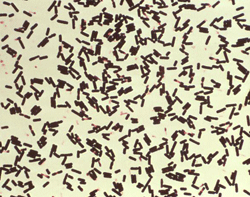Toxins and toxinotypes
This bacteria has five (5) different toxinotypes and four (4) major toxins. The toxinotypes are A, B, C, D, and E and the major toxins are named α(alpha), β (beta), ε(epsilon), ι (iota). The major difference between toxinotypes and the toxins is that the toxinotypes is a broad description and can contain one or more of the various toxins.
Toxinotype:
Type A- Most common in the environment
and is responsible for gas gangrene, food poisoning, and diarrhea in
humans. The common toxins that cause these symptoms for type A are α toxin and secondarily by θ toxin, and β2 toxin.
Toxinotypes: B, C, D, and E are much more rare when
looking at laboratory studies because they lose the plasmid that creates
their respected toxins after the first subculture. This remanding groups
of toxinotypes also are rare to cause disease, but it has been found
that some in type E have contained two
ι-toxin genes. The other major problem with this group is that they have
conjugation and swap plasmids with each other which doesn't allow for a
clear cut understanding of which group is the true harbor of the toxin.
Other genes that can causes disease caused by this organism are:
Clostridium perfringens enterotoxin (CPE), θ toxin, κ- collagenase and μ-
hyaluronidase. For the most part these various genes are found to be
relatively conserved because they have been found near the origin of
replication. Where as when dealing with all the other various toxins or
toxinotypes they are located on plasmids which does not keep them
completely contained within one bacterial cell.
CPE is a single polypeptide that contains 319 amino acids and is
responsible for binding with the host eukaryotic cell membrane. Upon
binding to the membrane protein, CPE in its bound form will move across
the cytoplasm until it is bound with second membrane protein.
Once these three proteins all combine the cell membrane will separate
which will allow the bacterial cell to enter into the cytoplasm.
